The Inner Ring
Sun
Size: 1,300,000 Earths
Equatorial Radius: 695,000 km
Rotational period (days): 25 (equator) – 36 (poles)
Minimum Surface Temperature: – –
Maximum Surface Temperature: – –
Age (Billions of Years): 4.5
Composition: Hydrogen (92.1%), Helium (7.8%)
Description
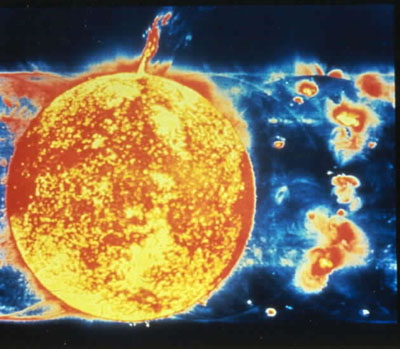
For many, the center of our world is the Earth, but those with perspective know that it is the Sun. This ball of fusion reactions is the campfire all life on Earth huddles around. Beyond it are the shadows of the unknown.
The Sun makes up 98% of the mass of our solar system. Solar energy is created deep within its core, where the temperature (15,000,000° C; 27,000,000° F) and pressure (340 billion times Earth’s air pressure at sea level) is so intense that hydrogen atoms fuse together to form helium. This atom is about .7 percent less massive than the two hydrogens, and the difference in mass is expelled as energy and carried to the Sun’s surface. Energy generated in the Sun’s core takes a million years to reach its surface.
The Sun appears to have been active for 4.6 billion years and has enough fuel to run for another five billion years or so. At the end of its life, the Sun will start to fuse helium atoms into heavier elements and swell up, ultimately growing so large it will swallow the Earth. After a billion years as a red giant, it will suddenly collapse into a white dwarf — the final end product of a star like ours, and may take a trillion years to cool off completely.
The Terrestrial Planets
Mercury
Mean Distance from the Sun: 57,910,000 km
Size: 0.4 Earths
Equatorial Radius: 2,439.7
Rotational period (days): 58.6
Orbital Period (days): 87.9
Minimum Surface Temperature: -173°C
Maximum Surface Temperature: 427°C
Age (Billions of Years): ????
Atmosphere: Helium (42%), Sodium (42%), Oxygen (15%)
Moons: none
Description
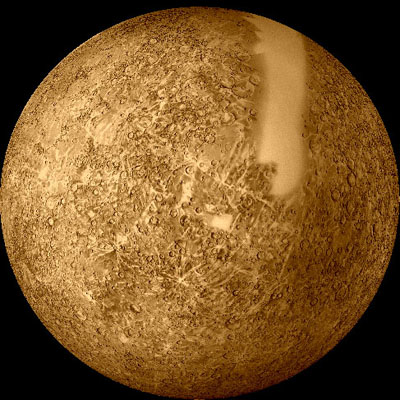
Closest to the sun, Mercury has only a tenuous atmosphere comprised of helium atoms captured from solar winds. The planet has some of the greatest temperature extremes in our solar system between its sunside and darkside.
Venus
Mean Distance from the Sun: 108,200,000 km
Size: 1 Earth
Equatorial Radius: 6,051.8
Rotational period (days): 224.7
Orbital Period (days): 243
Mean Surface Temperature: 482°C
Most Abundant Elements: Carbon Dioxide (96%), Nitrogen (3%)
Moons: none
Description
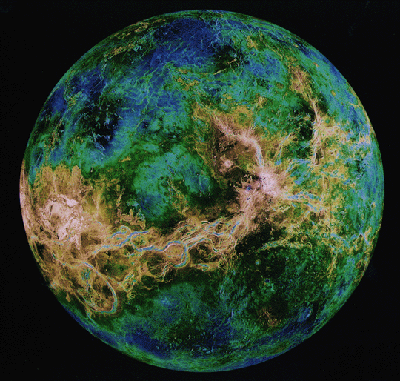
If there is one planet most like Hell, Carl Sagan tells us in his documentary series Cosmos, it is Venus. A planet smothered in Greenhouse gases and pressure cooked to such an extreme that the rocks are semi-liquids. This planet, the same size as ours and our closest neighbor, serves as a cautionary warning about how we should care for our own planet, lest we create a Hell on Earth.
Earth
Mean Distance from the Sun: 149,600,000
Size: 1 Earth
Equatorial Radius: 6,378.14
Rotational period (days): .9
Orbital Period (days): 365.3
Mean Surface Temperature: 15°C
Most Abundant Elements: Nitrogen (77%), Oxygen (21%)
Moons:
Description
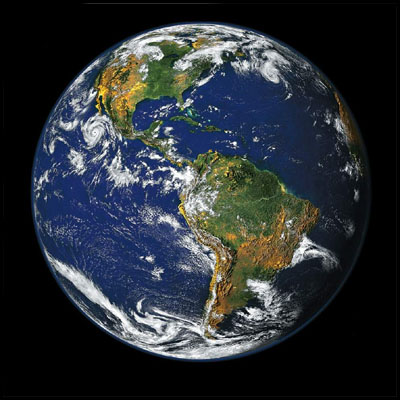
Possibly the most important photographs of the 1960s came from outside of Earth looking down on it. This new perspective on our world, a lone orb hovering in the darkness of space, demonstrated clearly how small and insignificant our Local and International differences are and placed us in the context of a global village.
Earth’s Moon – The Earth’s moon was most likely formed out of the earth itself. Computer simulations have show that a Mar-sized object probably hit the earth, casting debris into orbit around our planet. This debris eventually collected into the inspiring object decorating our night sky. This theory accounts for the moon’s orbit, which is nearly synchronous with the Earth’s rotation, and the moon’s high iron content, similar to the composition of the Earth’s.
Mars
Mean Distance from the Sun: 227,940,000
Size: 0.6 Earths
Equatorial Radius: 3,397.2
Rotational period (days): 24.6
Orbital Period (days): 687.0
Minimum Surface Temperature: -140°C
Maximum Surface Temperature: 20°C
Most Abundant Elements: Carbon Dioxide (95.3%), Nitrogen (2.7%), Argon (1.6%)
Moons: Phobos (1877), Deimos (1877)
Description
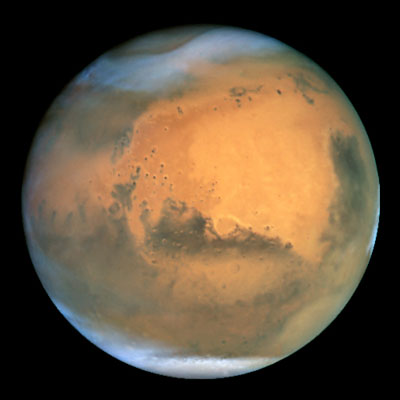
Mars has inspired endless speculation in Science Fiction from Edgar Rice Burroughs fantasy stories to Greg Bear’s Hard Science Fiction. Percival Lowell recorded a series of canals across Mars and speculated an entire civilization slowly dying as their water vanished into space. Today we know that Mars has no evidence of advanced civilizations, but we still hope for microscopic life. If bacteria can survive the extremes of Earth’s environment, then perhaps they can survive the journey between stars?
Mars has two moons, Phobos and Deimos. Phobos is getting closer to Mars every day. In about 50 million years it will either crash into Mars or be torn apart by gravity. Shreds of Phobos might then form a ring around Mars, similar to the rings of Saturn.
The Outer Ring
The Asteroid Belt
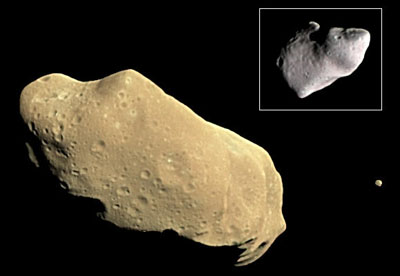
Between the vast stretch of space between Mars and Jupiter lies this ring of rocks. While some astronomers hypothesized this formation was debris from a protoplanet destroyed in a collision, most now agree it is material coalesced into small units that were never able to form a protoplanet due to Jupiter’s harsh gravitational pull. Pictured here is
243 Ida and its satellite Dactyl.
The Jovian Planets
Jupiter
Mean Distance from the Sun: 778,330,000
Size: ???? Earths
Equatorial Radius: 71,492
Rotational period (days): 0.4
Orbital Period (days): 4332.7
Mean Cloud Temperature: -121°C
Most Abundant Elements: Hydrogen (90%), Helium (10%)
Moons: Metis (1979), Adrastea (1979), Amalthea (1982), Thebe (1979), Io (1610), Europa (1610), Ganymede (1610), Callisto (1610), Leda (1974), Himalia (1904), Lysithea (1938), Elara (1905), Ananke (1951), Carme (1938), Pasiphae (1908), Sinope (1914), and 12 Additional Satelites discovered in 1999 and 2000.
Description

Jupiter is the largest of all planets and has more than twice the mass of all the planets combined. Jupiter, like the other gas giants, has an internal energy source. Jupiter’s anti-cyclone, the great red spot has been raging for at least the 400 years astronomer’s have observed it, and may continue for hundreds more driven by Jupiter’s internal heat. Gas giants are important for life on Earth because they sweep the solar system of debris that would otherwise threaten us.
Jupiter’s Moons – The moon’s Io, Europa, and Ganymede all orbit around Jupiter’s equator, leading astronomers to believe they formed out of left over material from the planet’s formation. Io is of interest to astronomers for its fantastic volcanic activity. Europa is of interest for the liquid water suspected to exist beneath its icy surface, where some scientists hypothesize life could form around volcanic vents as it does on Earth.
Saturn
Mean Distance from the Sun:
Size: Earths
Equatorial Radius: 60,268
Rotational period: 10.2 Hours
Orbital Period: 29.458 years
Mean Cloud Temperature: -125°C
Most Abundant Elements: Hydrogen (97%), Helium (3%)
Moons: Pan (1990), Atlas (1980), Prometheus (1980), Pandora (1980), Epimetheus (1966), Janus (1966), Mimas (1789), Enceladus (1789), Tethys (1684), Telesto (1980), Calypso (1980), Dione (1684), Helene (1980), Rhea (1672), Titan (1655), Hyperion (1848), Iapetus (1671), Phoebe (1898), and 12 New Satelites found in 2000.
Description
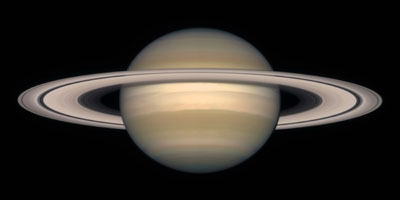
The second largest planet in the solar system, Saturn puts out more energy than it absorbs from the sun. Saturns rings are believed to be the result of a fragmented comet or pulverized moon. The least dense planet in our solar system, Saturn could float on water, should an ocean exist large enough to try this.
Saturn’s Moons – Prometheus and Pandora keep one of Saturn’s rings in place by herding the material there with gravity. Pandora orbits the outside of the ring, Prometheus on the inside. Scientists have been unable to predict the orbits of these two moons, which vary widely over time, leading astronomers to believe their orbits are chaotic. Of special interest to scientists is Titan, Saturn’s largest moon and the only moon in the solar system with thick cloud coverage comprised of organic building blocks.
Uranus
Mean Distance from the Sun: 2,870,990,000
Size: Earths
Equatorial Radius:
Rotational period: 17.9 hours
Orbital Period: 84 days
Mean Cloud Temperature: -193°C
Most Abundant Elements: Hydrogen (83%), Helium (15%), Methane (2%)
Moons: Cordelia (1986), Ophelia (1986), Bianca (1986), Cressida (1986), Desdemona (1986), Juliet (1986), Portia (1986), Rosalind (1986), Belinda (1986) , Puck (1985), Miranda (1948), Ariel (1851), Umbriel (1851), Titania (1787), Oberon (1787), Caliban (1997), Stephano (1999), Sycorax (1997), Prospero (1999), Setebos (1999), and 1986U10 (1999).
Description
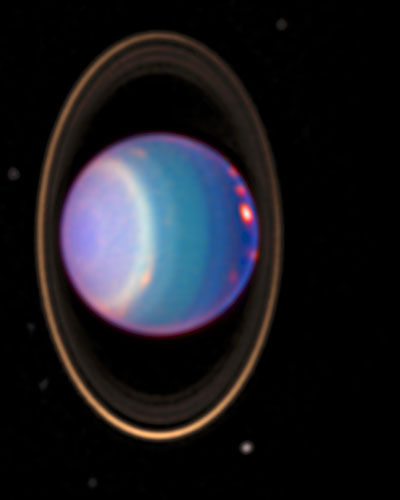
Uranus was the first planet discovered in modern times. Uranus orbits the sun with its axis tilted on its side, so half the time one pole is toward the sun and then the other making each of the four seasons last about 20 years. This may be the result of some ancient collision with another celestial body.
Neptune
Mean Distance from the Sun: 4,504,300,000
Size: Earths
Equatorial Radius: 24,746
Rotational period: 16.11 hours
Orbital Period: 164.8 years
Mean Cloud Temperature: -193 to -153°C
Most Abundant Elements: Hydrogen (83%), Helium (13%), Methane (2%)
Moons: Naiad (1989), Thalassa (1989), Despina (1989), Galatea (1989), Larissa (1989), Proteus (1989), Triton (1846), and Nereid (1949).
Description
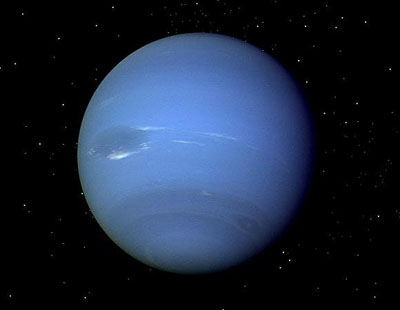
The second planet discovered in modern times, Neptune was located after astronomers observed some unknown body was perturbing Uranus’ orbit. Neptune has a dark spot similar to Jupiter’s red spot. Unlike Jupiter’s anti-cyclone, Neptune’s storms apparently do not last hundreds of years, although no one knows why.
The Kuiper Belt
In 1992, astronomers became aware of a vast population of small bodies orbiting the sun beyond Neptune. There are at least 70,000 of these “trans-Neptunians” in the radial zone extending outwards from the orbit of Neptune. These are mostly confined within a thick band around the ecliptic, creating a belt surrounding the sun.
Pluto
Mean Distance from the Sun: 5,913,520,000
Size: Earths
Equatorial Radius: 1,137
Rotational period (days): 6.4
Orbital Period: 248.5 years
Minimum Surface Temperature: -240°C
Most Abundant Elements: Methane, Nitrogen
Moons: Charon
Description
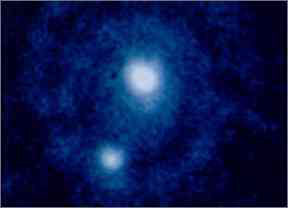
Usually the furthest planet in our solar system, Pluto does briefly come closer to the sun than Neptune for 20 years of its orbit. Pluto is the largest of the Kuiper Belt objects and its atmosphere is frozen to its surface for much of its orbit.
Planet X – Sedna
Little is known about Sedna, which is probably composed mostly of ice in the Kuiper belt. Its discovery has sparked a new debate over what constitutes a planet and has called Pluto’s status as a planet into question.
The Oort Cloud
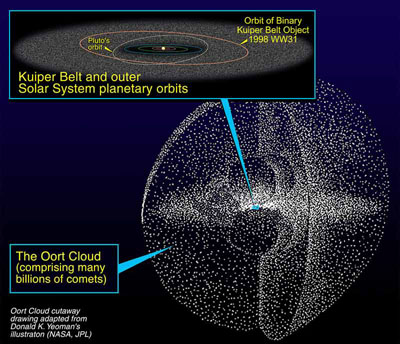
This cloud of debris encircles our solar system, and is comprised of billions of chunks of ice, which produce the many comets that occasionally pass through our solar system.
The Milky Way
Stars Are Born…
Gaseous Pillars in the Eagle Nebula
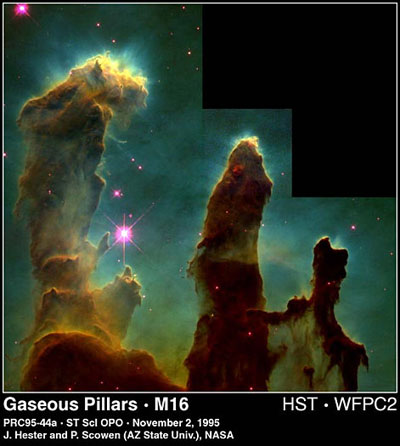
In the constellation Serpens, 7,000 light-years away, vast columns of molecular hydrogen, light-years in length, are dense enough to generate the enormous pressure required to force hydrogen atoms into fusion reactions. These pockets of interstellar gas are called evaporating gaseous globules (EGGs) and are located, appropriately enough, in the Eagle Nebula, a star hatchery. These are Embryonic stars.
Protoplanetary Disk in the Orion Nebula
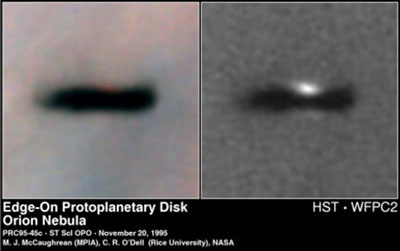
These globules of gas are what our solar system looked like in its earliest stages. At their center, the clouds of molecules are condensing with enough pressure to possibly generate a star. When that happens, the remaining, uncollected gas will disperse from solar winds, leaving only whatever planets have coagulated from the disk. These are Embryonic solar systems.
…and Stars Die
Hourglass Planetary Nebula
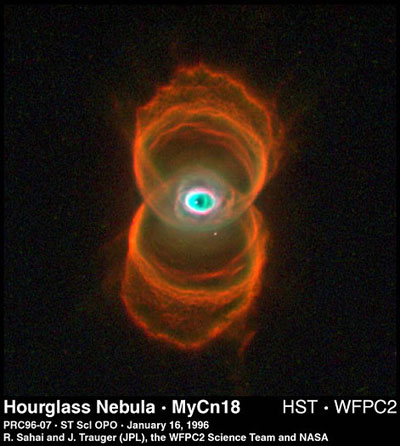
The star V Hydrae is in its final death throes. It throws off jets of gas in a dazzling geometric display we know very little about. This image come from 8,000 light-years away.
Monocerotis
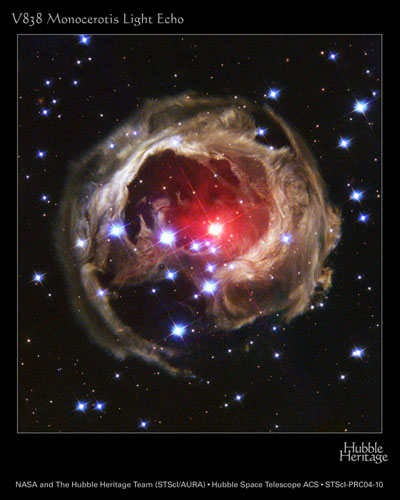
20,000 light-years away, at the edge of our galaxy, V838 Mon is another dying star. Flashes from its death throes have drawn astronomers to watch its expanding bubble of gas and turbulence.
Cat’s Eye Nebula
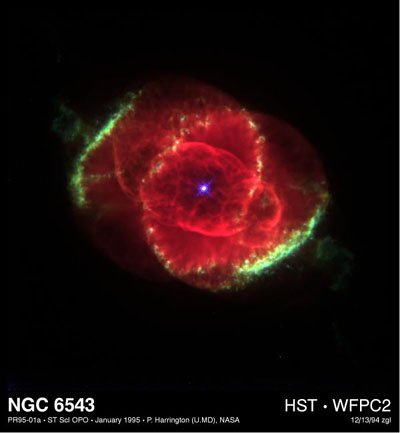
This nebula, only 3,000 light-years away in the Northern constellation Draco, is so complex that astronomers believe the bright spot at its center may be a binary star system. There are many layers of gas shown here, approximately 1,000 years old, this planetary nebula provides a visual ‘fossil record’ of its past.
Twin Jet Nebula

2,100 light-years away in the constellation Ophiucus, the dying star at the heart of M-29 fires gases in twin streams away from itself at speeds greater than 200 Miles Per Second. As the nature of these two massive vents of gas is much like a jet’s flame, the name is very apropo.
A Bow Shock Near a Young Star
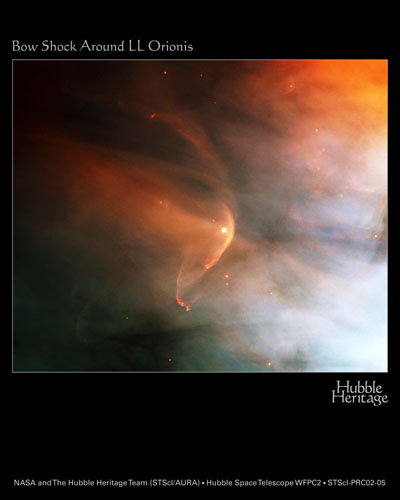
Taking place in the great Orion Nebula, this picture reveals what happens when two rivers of gas collide. In this case, the solar winds coming out of the star create an arc in the winds of the Orion nebula. This image takes place a mere 1,500 light years away from us. Can you find the second bow shock in this scene?
The Bubble Nebula
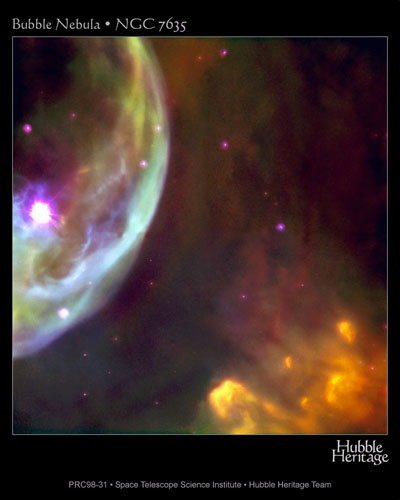
Similar to the bow shock, this picture shows an expanding bubble of gas being pushed away from the bright, massive star in the picture, which generates the solar winds.
Cometary Knots

Hubble captured thousands of these knots from a doomed star in the Helix nebula, the closest planetary nebula to Earth at 450 light-years away in the constellation Aquarius. Each gaseous head is at least twice the size of our solar system; each tail stretches 100 billion miles, about 1,000 times the Earth’s distance to the Sun.
Mystery Picture

If anyone can determine the authenticity or identify what this is a picture of, I would greatly appreciate it. The website I retrieved it from labeled it a “super nova,” but it appears to more resemble a bubble nebula.
The Cosmos
When galaxies collide (quicktime required).
The “Sombrero” Galaxy
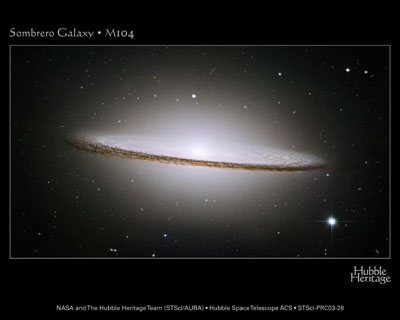
28 Million light-years from Earth, this galaxy’s mass is equivalent to 800 Billion suns.
The “Black Eye” or “Evil Eye” Galaxy

The merging of two galaxies has created this interesting visual effect. In the 1990’s, it was discovered that the galaxy’s outer ring of gas moves in a direction opposite its inner ring.
The “Tadpole” Galaxy
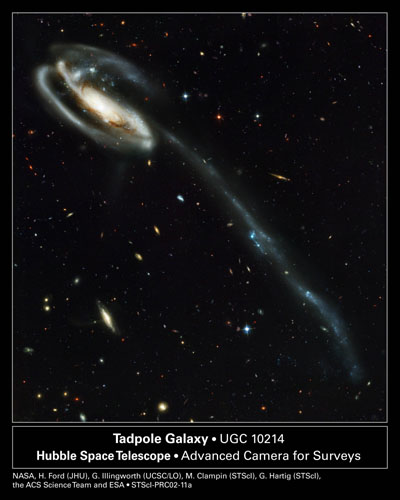
Leaving a long trail of stars behind as it streams across the cosmos like a pinwheel of fireworks, this galaxy is the result of a “hit and run” with the small, bluish and denser galaxy visible through the galaxy in the upper left portion of the picture, which is now racing away into the background.
The Cartwheel Galaxy
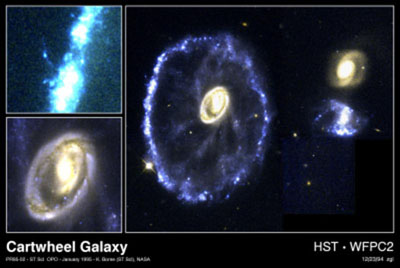
The result of direct galactic collision. There are actually two galaxies pictured here. There is the smaller, denser galaxy at the center of the circle, and the ring of blue star formation that was “poofed” out from the collision.
The “Backwards” Galaxy
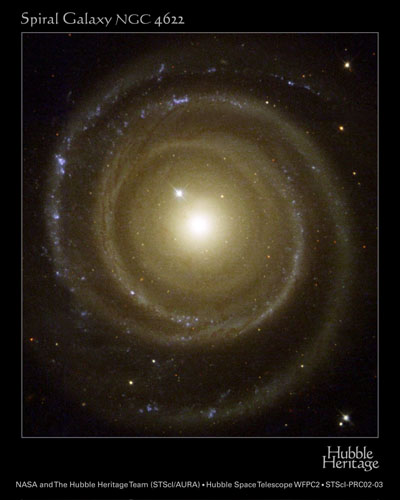
This object dances to the beat of a different drummer as it spins in a direction opposite what we would expect. The arms in this image are actually spiraling clockwise, believed to be the result of interaction with a passing galaxy.
Seyfert’s Sextet
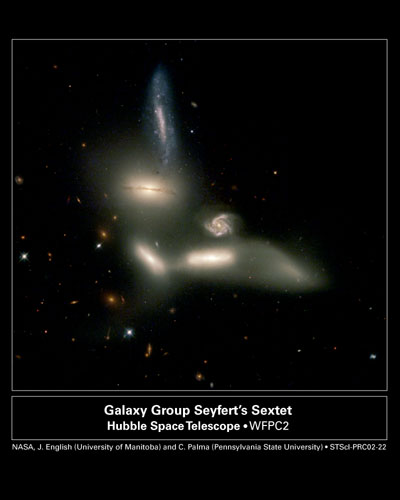
This group of galaxies are slowly tearing each other apart, throwing stars out into the cosmos as they dance around one another. Eventually they may condense to form a single, massive galaxy in a process that will take billions of years. The four galaxies interacting here have less volume than our own, Milky Way galaxy.
The Deep Deep Field

Pictured here is the most distant known galaxy in the universe. 13 Billion light-years away, what we are seeing is what the universe looked like a mere 750 Million years after the Big Bang. The image was enhanced using the Hubble telescope, CARA’s W.M. Keck Telescopes in Hawaii, and a naturally occurring “cosmic gravitational lens,” where the gravity of objects in space helped to magnify the image. Beyond this image, in the blackness of space, we are seeing what the universe looked like before stars and galaxies formed, a black haze of hydrogen gas. This is the edge of the universe.
Beyond…
Is there life elsewhere in the Cosmos or are we unique? Frank Drake has shed some light on this by compiling all of the chance factors that brought the human race to this point into an equation that estimates the probability of it occurring elsewhere in our galaxy.
The Drake Equation
After playing with this equation, we find a high probability that there are at least a few communicating civilization in our own galaxy. If such life exists and we have been searching the skies for it with telescopes and radio receivers, why haven’t we found it?
Fermi’s Paradox
Enrico Fermi proposed that considering the age of the Universe and providing for even a single civilization forming in our galaxy to colonize it at a steady rate, we should have encountered alien life by now. In fact, the Universe should be teeming with life.
Perhaps colonization is not the ultimate goal of civilization. Perhaps the physical dimensions of our universe is not all there is to it. Perhaps life is simply really really difficult to see? Looking at the family portrait of our solar system, how would anyone know life existed on our planet?
Another thing to consider is the exponential growth of our intelligence. It took billions of years for our ancestors to appear on the Earth. It took the human race millions of years to evolve into a basic tool-using species congregating in tribes. It then took tens of thousands of years for us to form larger societies with laws and structures of thought. A few thousand years later, we entered an industrial age. One-hundred years after that, we began our communications revolution. Within a few decades we have begun to open the doors to a genetics revolution.
We are getting smarter faster. One reason we may not have been visited by extraterrestrials is that they would find it unethical to visit us. The human race has only interacted with its more primitive cultures to take from them. What could a being with the capability of traveling hundreds of thousands of light-years possibly want to take from us, other than anonymous observations?
The Search Continues
Scientists are looking for microscopic life everywhere in our solar system now. We are searching Mars with rovers, sending satellites to Titan, planning trips to Europa, and searching our uppermost atmosphere for alien bacteria raining down on us. If we find microscopic life elsewhere, the numbers in the Drake equation will change.

First picture of a Martian?
Modern magnetotactic bacteria, showing a chain of magnetite crystals. Bottom: Chains of magnetite crystals in the Martian meteorite ALH84001
Similarly we are scanning the Cosmos for any signal from a distant civilization. The SETI program has been at this for years, tirelessly scanning the skies for radio messages from far away. They have even enlisted the help of the online community with their SETI at home program, where idle computers are volunteered to analyze the data packets that come in. Even if the SETI program does not discover life, it will still tell us something about how common intelligent life is in the universe.